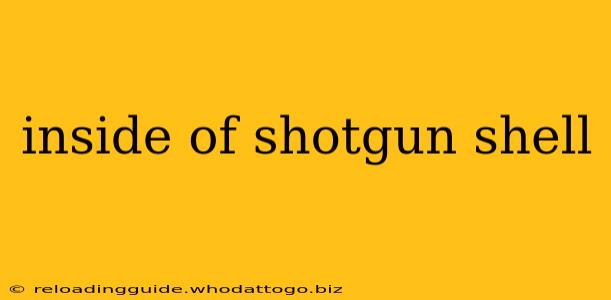Shotgun shells, while seemingly simple, are complex pieces of engineering designed for a specific purpose: delivering a payload of shot, slugs, or other projectiles with considerable force. Understanding the components within a shotgun shell is crucial for safe handling, proper function, and appreciating the ballistics involved. This detailed exploration will dissect the anatomy of a shotgun shell, explaining each part and its role.
The Anatomy of a Shotgun Shell: A Layer-by-Layer Examination
A standard shotgun shell comprises several key components, each playing a vital role in its operation. Let's examine them in detail:
1. The Case (Hull):
The case, or hull, is the outer shell of the cartridge, typically made from paper, plastic, or a combination of both. Its function is primarily to contain all the other components and provide structural integrity during firing. The material used influences factors like cost, durability, and recyclability. You'll find variations in case length, directly correlating with the shell's gauge and the amount of shot it can hold.
2. The Primer:
Located at the base of the shell, the primer is a small, sensitive explosive charge. When struck by the firing pin of the shotgun, the primer ignites, initiating the chain reaction that propels the shot. Different primer types exist, varying in sensitivity and performance characteristics.
3. The Powder Charge:
This is the propellant, a carefully measured amount of gunpowder. The type and amount of powder significantly impact the velocity and pressure of the shot. Faster-burning powders generate higher pressures, resulting in faster shot velocities, while slower-burning powders provide a smoother recoil. Understanding the powder's burn rate is vital for optimal performance and safety.
4. The Wad:
Positioned above the powder charge, the wad acts as a seal, preventing gas leakage and ensuring proper shot delivery. It also helps to cushion the shot and maintain its pattern as it travels down the barrel. Wads come in various designs, including felt, fiber, and plastic, each offering different advantages in terms of pattern, recoil, and cost.
5. The Shot:
This is the primary projectile, consisting of numerous small lead or steel pellets. The size and number of shot pellets vary depending on the intended use, from small birdshot for hunting small game to larger buckshot for larger animals or self-defense. Steel shot is increasingly popular due to its non-toxic nature, but it can be harder on shotgun barrels.
6. The Crimp:
The crimp is the sealed closure at the top of the shell, securing all the internal components. It is crucial for maintaining the integrity of the cartridge and preventing premature ignition or leakage of the powder. The crimp's design can vary between manufacturers and types of shells.
Beyond the Basics: Variations and Considerations
While the components listed above represent the standard construction, variations exist depending on the type of ammunition. Slugs, for example, replace the shot with a single projectile for greater accuracy at longer ranges. Different types of shot, such as steel or bismuth, cater to specific needs and regulations. Understanding these variations is essential for safe and effective use.
Safety First: Handling Shotgun Shells Responsibly
Always handle shotgun shells with care. Avoid dropping them, exposing them to excessive heat, or tampering with their internal components. Improper handling can lead to misfires, premature explosions, or other dangerous situations. Always store ammunition in a cool, dry place away from children and unauthorized individuals.
This comprehensive guide offers a detailed understanding of the components inside a shotgun shell. While not an exhaustive treatise, it aims to provide a solid foundation for those seeking to understand the mechanics and functionality of this crucial component of firearms. Remember, safe and responsible handling is paramount.

